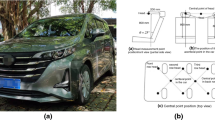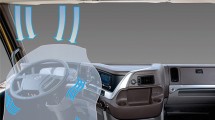Abstract
In order to improve the comfort of riding vehicles, this paper focuses on the automatic air-conditioning controller by introducing the principle of air-conditioner and the design of hardware and software. The controller controls different actuators to achieve the automatic control of head temperature according to automatic control algorithm. Finally, the experiments revealed that the system is stable to achieve the desired requirements.
Access provided by CONRICYT-eBooks. Download conference paper PDF
Similar content being viewed by others
Keywords
51.1 Introduction
With the continuous development of automotive industry, car owners’ demand for riding comfort has been increased. Automatic air-conditioner that can keep the driver’s head temperature close to the setting temperature on panel plays an important role in a vehicle and has an positive impact on riding comfort. As the core component and the brain of the air-conditioner, air-conditioning controller controls all movements to provide cooling and heating capacity [1].
Figure 51.1 shows an automobile air-conditioner, which mainly consists of blower, compressor, evaporator, heating core, air mix door motor, mode door motor and other components. The blower intakes air from the air inlet and controls winds’ blowing speed [2]. When the compressor is connected to engine by the clutch, it will be operating. The liquid refrigerant flows through the evaporator, and changes into gas by absorbing heat of evaporate, which will reduce the temperature of the air blowing through the evaporator [3]. When the engine starts, the temperature of heating core connected with engine coolant pipe and the air through it will rise rapidly. The air mix door motor controls the ratio of hot air and cold, and the mode door motor controls the direction of the wind blowing out.
51.2 Hardware Design
Automatic air-conditioner should control all actuators to ensure that the driver’s head temperature is always close to the setting temperature on the vehicle panel according to the change of the ambient temperature, the cabin temperature, the evaporator temperature and sunlight intensity. Therefore, the circuit of automatic air-conditioning controller must include the acquisition circuits to acquire these temperatures and sunlight intensity and the driving circuits to control the blower and door motors [4].
51.2.1 Signal Acquisition Circuit
The resistance of temperature sensor can be changed with different temperature, and the resistance of sunlight intensity sensor can be changed with different sunlight intensity. The signal acquisition circuit is shown in Fig. 51.2, where, \( {\text{R}}_{\text{sensor}} \) is the sensor’s resistance, \( {\text{Vcc}} \) is the 5 V voltage in the controller, \( {\text{V}}_{\text{AD}} \) is the voltage collected by MCU (micro control unit). Finally we will get the temperature or sunlight intensity based on the relationship between temperature and resistance or the relationship between sunlight intensity and resistance.
51.2.2 Circuit for Controlling Blower
The air-conditioning controller controls the speed of blower by providing different driving voltages to the driving module. In Fig. 51.3, a 1 kHz PWM signal sent by the MCU can be switched into a controlling voltage through a high side driver and a two-stage RC filter, which can be changed within a range of 0–5 V by adjusting the duty of the PWM signal.
51.2.3 Circuit for Controlling Motor
Door motor in air-conditioning system is controlled by the servo motor with position feedback, whose position can be calculated by the signal acquisition circuit described in Sect. 51.2.1.
As shown in Fig. 51.4, the MCU controls motors by a half-bridge driver chip, in which MOSI, MISO, SCK, SS are the SPI communication interfaces with MCU. OUT1 to OUT4 are four output ports, which are separately connected with the cold side of the air mix door, the hot side of the air mix door, the face side of the mode door, and the defrost side of the mode door. Take the air mix door motor for example, when OUT1 is high and OUT2 is low, the air mix door motor will rotate to the cold side, when OUT1 is low and OUT2 is high, the air mix door motor will rotate to the hot side, and when OUT1 and OUT2 are both low, the air mix door motor will stop. The MCU could control the motor staying in any position by adjusting the output of OUT1 to OUT4 according to its feedback in real time.
51.3 Software Design
51.3.1 Calculation of the Target Outlet Temperature
Target outlet temperature is the key variable of automatic air-conditioning algorithm and directly affects all actuators in the air-conditioning system. It could be calculated by the formula: \( {\text{TAO}} = {\text{f}}_{1} ({\text{Tset}}) - {\text{f}}_{2} ({\text{TR}},{\text{TAM}}) - {\text{k}}_{1} \times {\text{TS}} \), where TAO is the target outlet temperature, Tset is the setting temperature, TR is the cabin temperature, TAM is the ambient temperature, TS is the sunlight intensity, and k1 is the sunlight parameter [5].
51.3.2 Automatic Control of Blower
Blower is an important actuator of air-conditioning system. Its speed directly determines the wind volume. We should match the starting voltage \( V_{1} \) depending on the characteristic of different blower types. When the blower is started, the controlling voltage must be kept at \( V_{1} \) for 2 s to ensure a smooth start and improve the lifetime of the blower.
According to the circuit, the controlling voltage of the blower in automatic air-conditioner is \( V_{blower} = K_{2} \times TAO^{2} + C \), \( V_{blower} \in [V_{2} ,5] \), where \( k_{2}^{{}} \) and C are determined by the environment simulation experiment, \( V_{2} \) is the controlling voltage when blower is 1st wind volume.
In winter, the temperature of engine water (TW) can not rise rapidly to 40 °C slightly higher than the body temperature of human being. In order to avoid blowing out the cold wind, the ECU should do a pre-heating control according to the temperature of engine water. When \( TW \le 40 \), \( V_{3} = f_{3} (TW) \). In summer, the compressor can not reduce the temperature of evaporator (TE) rapidly. In order to avoid blowing out the hot air, the ECU should do a pre-cooling control according to the temperature of evaporator. When \( TE \ge 30 \), \( V_{4} = f_{4} (TE) \). Finally, the controlling voltage of blower is determined by \( V_{blower} = \hbox{min} (V_{blower} ,V3,V4) \). The flow chart of blower control is shown in Fig. 51.5.
51.3.3 Automatic Control of Compressor
Compressor is the only refrigerating source of automotive air-conditioning system. It compresses low-pressure gaseous refrigerant to high pressure gaseous refrigerant, which will come into the evaporator and take away its heat. When the air sucked by the blower blows through the evaporator surface, it will become cold by heat exchange. If the compressor has been in operation continuously, it will not only be a waste of engine torque which stands for vehicle energy, but also make evaporator be frozen which may break the air-conditioning system down. If the compressor is stopped, air-conditioner will lose its cooling function. Therefore, in software, when the evaporator temperature is lower than \( TE_{1} \), the compressor will be stopped, and when the temperature is higher than \( TE_{2} \), the compressor will return to work. \( TE_{1} = f_{5} (TAO) \), \( TE_{1} \in [1,10] \), \( TE_{2} = TE_{1} + 2 \).
51.3.4 Automatic Control of Motor
As shown in Fig. 51.1, air mix door motor allocates the volume of cold air blowing through the heating core, which will come together with other cold air. The position of the air mix door motor that determines the outlet temperature can be calculated by the formula \( SWD = f_{6} (TAO,TW,TE) \), where \( SWD \in [0\% ,100\% ] \).
According to thermodynamics and related air-conditioning experiences, people do not want the cold air to blow foot and the hot air to blow face. In the software design of automatic air-conditioning controller, the relation between the position of mode door and TAO should be considered. When TAO is higher than T1, the mode door should be at the position of blowing foot. When TAO is lower than T1 but higher than T2, the mode door should be at the position of blowing foot and face. However, when TAO is lower than T2, the mode door should be at the position of blowing foot.
51.4 Experiment Results
In order to verify the effect of the automatic air-conditioning controller, the author conducted an experiment on a vehicle equipped the designed controller in the winter of Heihe and in the summer of Sanya, in which the setting temperature was set at 25°.
In December, the ambient temperature in Heihe is about −20 °C. As shown in Fig. 51.6, after the air-conditioner was started up, the head temperature could reach 25 °C in 20 min, and be at a stable state within 10 min, indicating that the automatic heating control can meet the requirements.
In July, the ambient temperature in Sanya is about 36 °C, the strongest sunlight intensity is about 1 kW. As shown in Fig. 51.7, after the air-conditioner was started up, the head temperature could reach 25 °C in 5 min, and be at a stable state within 10 min, which indicated that the automatic cooling control can meet the requirements.
51.5 Conclusion
This research developed an automatic air-conditioning controller, which controlled the blower, compressor, door motor and achieves automatic control of the head temperature by collecting the ambient temperature, the cabin temperature and sunlight intensity. Experiments on the vehicle equipped with automatic air-conditioning controller revealed that the designed controller is high-precision and helpful for improving riding comfort.
References
Bedbak SS, Gopal MR (2005) Performance analysis of a compressor driven metal hydride cooling system. Hydrogen Energy 30(10):1127–1137
Fan Y-q, Hayashi T, Ito K (2012) Coupled simulation of BES-CFD and performance assessment of energy recovery ventilation system for office model. J Cent South Univ 19(3):633–638
Kim KJ, Montoya B, Razani A (2001) Metal hydride compacts of improved thermal conductivity. Hydrogen Energy 26(6):609–613
Ahmed SS, Murthy SS (2004) Analysis of a novel metal hydride cycle for simultaneous heating and cooling. Renew Energy 29(4):615–631
Sanchez AR, Klein HP, Groll M (1999) Expand graphite as heat transfer matrix in metal hydride beds. Hydrogen Energy 28(5):515–527
Author information
Authors and Affiliations
Corresponding author
Editor information
Editors and Affiliations
Rights and permissions
Copyright information
© 2017 Springer Nature Singapore Pte Ltd.
About this paper
Cite this paper
Yang, B., Wang, M., Huang, T.S., Peng, F., Xin, C. (2017). Research on Automatic Automobile Air-Conditioning Controller. In: Proceedings of SAE-China Congress 2016: Selected Papers. SAE-China 2016. Lecture Notes in Electrical Engineering, vol 418. Springer, Singapore. https://doi.org/10.1007/978-981-10-3527-2_51
Download citation
DOI: https://doi.org/10.1007/978-981-10-3527-2_51
Published:
Publisher Name: Springer, Singapore
Print ISBN: 978-981-10-3526-5
Online ISBN: 978-981-10-3527-2
eBook Packages: EngineeringEngineering (R0)











